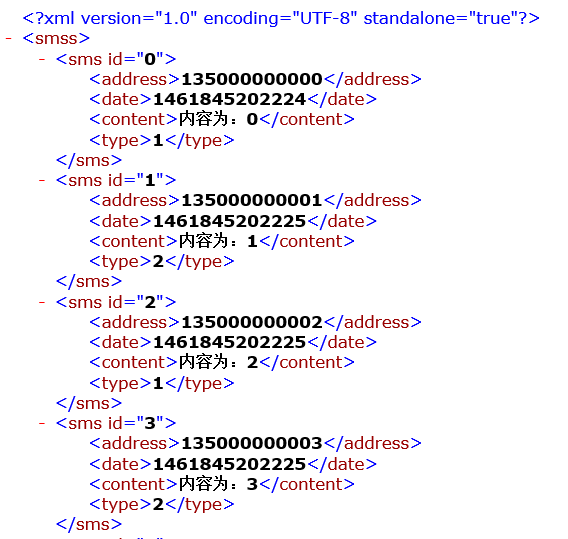SharePreference是如何实现的——序列化XML文件
还记得上一篇我们讲到了用SharePreference来存储数据,那么究竟它是如何实现的呢,今天我们就来仔细看看其实现的细节,我们给它一个准确的名字,叫做XML序列化器(XmlSerializer)。
不同于上面一篇的保存用户的登录名以及密码,这次我们保存设备中的信息,但是由于现在知识有限,我还不能够实现对设备中信息的读取,那么我就在程序中自己生成若干条信息,对这些生成的信息进行读取,并保存到位于SD卡的backup.xml文件中。在这里我是用两种方法对其进行存储并比较两种方法的优缺点,当然作为开发,我更建议使用待会讲到的第二种方法。
先来看看我们需要做到什么样的效果:

图一
第一种方法:使用StringBuffer,将所有的内容逐一追加到该字符流中。
public void backUpSms1(View view){
StringBuffer sb=new StringBuffer();
sb.append("<?xml version=\"1.0\" encoding=\"UTF-8\" ?>");
sb.append("<smss>");
for (SmsInfo smsinfo: smsInfo) {
sb.append("<sms>");
sb.append("<address>");
sb.append(smsinfo.getAddress());
sb.append("</address>");
sb.append("<date>");
sb.append(smsinfo.getDate());
sb.append("</date>");
sb.append("<content>");
sb.append(smsinfo.getContent());
sb.append("</content>");
sb.append("<type>");
sb.append(smsinfo.getType());
sb.append("</type>");
sb.append("</sms>");
}
sb.append("</smss>");
try {
File file =new File(Environment.getExternalStorageDirectory(), "backUp1.xml");
FileOutputStream fos =new FileOutputStream(file);
fos.write(sb.toString().getBytes());
fos.close();
Toast.makeText( this, "备份成功",0).show();
} catch (Exception e) {
e.printStackTrace();
Toast.makeText( this, "备份失败",0).show();
}
}
第一种方法相当简单,只是用了一个字符流,将所有的内容逐一追加就行了,可是当我们的短信中出现了一些比较特殊的字符,例如:"<"或者是">"那么在读取并写入到xml文件的时候就会出错,这个时候打开该xml文件的时候将会报错;另外当我们需要在sms标签中加入一些属性,如图一所示,那么这个时候仅仅利用字符流来写就会变得冗杂,而且逻辑关系就不严谨了,所以这个时候我们就需要用到第二种方法了。
第二种方法(推荐):XML序列化器(使用XmlSerializer编辑xml文件)
public void backUpSms2(View view) {
try {
//初始化序列号器,指定xml写入到哪个文件并指定写入的编码格式
XmlSerializer xmlSerializer =Xml.newSerializer();
File file =new File(Environment.getExternalStorageDirectory(), "backUp2.xml");
FileOutputStream fos=new FileOutputStream(file);
xmlSerializer.setOutput(fos,"utf-8");
xmlSerializer.startDocument("utf-8", true);//开始声明文件
xmlSerializer.startTag(null, "smss");//开始最外层标签
for (SmsInfo sms : smsInfo) {
xmlSerializer.startTag(null, "sms");//写入第一个标签
xmlSerializer.attribute(null, "id", sms.getId()+"");//第一个标签的属性
xmlSerializer.startTag(null, "address");//写入内一层的标签
xmlSerializer.text(sms.getAddress());
xmlSerializer.endTag(null, "address");
xmlSerializer.startTag(null, "date");//写入内一层的标签
xmlSerializer.text(sms.getDate()+"");
xmlSerializer.endTag(null, "date");
xmlSerializer.startTag(null, "content");//写入内一层的标签
xmlSerializer.text(sms.getContent());
xmlSerializer.endTag(null, "content");
xmlSerializer.startTag(null, "type");//写入内一层的标签
xmlSerializer.text(sms.getType()+"");
xmlSerializer.endTag(null, "type");
xmlSerializer.endTag(null, "sms");//结束标签
}
xmlSerializer.endTag(null, "smss");//结束最外层标签
xmlSerializer.endDocument();//结束声明文件
fos.close();//记得一定要关闭输出流
Toast.makeText( this, "备份成功",0).show();
} catch (Exception e) {
e.printStackTrace();
Toast.makeText( this, "备份失败",0).show();
}
}
使用XmlSerializer的时候有几个步骤:1、首先需要找到输出流,即通过setOutput方法将输出流以及编码格式传入;2、接着需要声明文件以及结束声明,这是通过startDocument以及endDocument这两个方法来实现的;3、接着就可以通过startTag以及startTag方法来声明标签以及结束标签,要声明标签的内容的时候可以通过text方法,当然这个方法只能允许传入String类型,所以对于其他数据类型,需要先对其进行转换;4、最后一点就是上面讲到的——要在标签中添加属性,那就需要通过attribute方法声明id属性。
通过以上的讲解,我们可以得到以下的xml文件:
<?xml version="1.0" encoding="UTF-8" standalone="true"?> -<smss> -<sms id="0"> <address>135000000000</address> <date>1461845202224</date> <content>内容为:0</content> <type>1</type> </sms> -<sms id="1"> <address>135000000001</address> <date>1461845202225</date> <content>内容为:1</content> <type>2</type> </sms> -<sms id="2"> <address>135000000002</address> <date>1461845202225</date> <content>内容为:2</content> <type>1</type> </sms> -<sms id="3"> <address>135000000003</address> <date>1461845202225</date> <content>内容为:3</content> <type>2</type> </sms> -<sms id="4"> <address>135000000004</address> <date>1461845202225</date> <content>内容为:4</content> <type>2</type> </sms> -<sms id="5"> <address>135000000005</address> <date>1461845202225</date> <content>内容为:5</content> <type>2</type> </sms> -<sms id="6"> <address>135000000006</address> <date>1461845202225</date> <content>内容为:6</content> <type>2</type> </sms> -<sms id="7"> <address>135000000007</address> <date>1461845202225</date> <content>内容为:7</content> <type>2</type> </sms> -<sms id="8"> <address>135000000008</address> <date>1461845202225</date> <content>内容为:8</content> <type>1</type> </sms> -<sms id="9"> <address>135000000009</address> <date>1461845202225</date> <content>内容为:9</content> <type>2</type> </sms> -<sms id="10"> <address>135000000010</address> <date>1461845202225</date> <content>内容为:10</content> <type>1</type> </sms> -<sms id="11"> <address>135000000011</address> <date>1461845202225</date> <content>内容为:11</content> <type>2</type> </sms> -<sms id="12"> <address>135000000012</address> <date>1461845202225</date> <content>内容为:12</content> <type>2</type> </sms> -<sms id="13"> <address>135000000013</address> <date>1461845202225</date> <content>内容为:13</content> <type>2</type> </sms> -<sms id="14"> <address>135000000014</address> <date>1461845202225</date> <content>内容为:14</content> <type>2</type> </sms> -<sms id="15"> <address>135000000015</address> <date>1461845202225</date> <content>内容为:15</content> <type>1</type> </sms> -<sms id="16"> <address>135000000016</address> <date>1461845202225</date> <content>内容为:16</content> <type>1</type> </sms> -<sms id="17"> <address>135000000017</address> <date>1461845202225</date> <content>内容为:17</content> <type>1</type> </sms> -<sms id="18"> <address>135000000018</address> <date>1461845202225</date> <content>内容为:18</content> <type>2</type> </sms> -<sms id="19"> <address>135000000019</address> <date>1461845202225</date> <content>内容为:19</content> <type>1</type> </sms> </smss>
2016-04-29
BOB
--开始忙碌的五一
SharePreference是如何实现的——序列化XML文件的更多相关文章
- 如何引用XML文件生成C#类
目录 XSD File Generate Class File Simply. 1 Why use XSD file to create C# classes?... 2 How to convert ...
- Android 使用xml序列化器生成xml文件
在<Android 生成xml文件>一文中使用流的形式写入xml格式文件,但是存在一定的问题,那就是在短信内容中不能出现<>之类的括号,本文使用xml序列化器来解决 xml序列 ...
- 使用XML序列化器生成XML文件和利用pull解析XML文件
首先,指定XML格式,我指定的XML格式如下: <?xml version='1.0' encoding='utf-8' standalone='yes' ?> <message&g ...
- XML文件序列化和反序列化的相关内容
问题缘由: XML反序列化出错,XML 文档(2, 2)中有错误,不应有 <configuration xmlns=''> 解决方法: 其实这个是很简单的,因为一般来说都是XML文档书写错 ...
- 使用XMl序列化器生成xml文件
生成XML文件 创建几个虚拟的短信对象,存在list中 备份数据通常都是备份至sd卡 使用StringBuffer拼接字符串 把整个xml文件所有节点append到sb对象里 sb.append(&q ...
- WebAPI调用笔记 ASP.NET CORE 学习之自定义异常处理 MySQL数据库查询优化建议 .NET操作XML文件之泛型集合的序列化与反序列化 Asp.Net Core 轻松学-多线程之Task快速上手 Asp.Net Core 轻松学-多线程之Task(补充)
WebAPI调用笔记 前言 即时通信项目中初次调用OA接口遇到了一些问题,因为本人从业后几乎一直做CS端项目,一个简单的WebAPI调用居然浪费了不少时间,特此记录. 接口描述 首先说明一下,基于 ...
- Android中XML文件的序列化生成与解析
xml文件是非常常用的,在android中json和xml是非常常用的两种封装数据的形式,从服务器中获取数据也经常是这两种形式的,所以学会生成和解析xml和json是非常有用的,json相对来说是比较 ...
- XML文件的写,集合XML序列化(写)。XML文件的读,递归遍历
XML文件:必须要有一个节点.检验xml文件,可以用浏览器打开,能打开表示对,否则错. 处理方法: DOM:XmlDocument文档对象模型 Sax(事件驱动,XmlReader) XmlSeria ...
- Android -- 创建XML文件对象及其序列化, pull解析XML文件
1. 创建XML文件对象及其序列化 示例代码:(模拟以xml格式备份短信到SD卡) SmsInfo.java, bean对象 /** * 短信的业务bean * @author Administrat ...
随机推荐
- 二叉平衡查找树AvlTree(C实现)
二叉平衡查找树即是一棵树中所有节点的左右子树高度差不超过1的查找树 头文件—————————————————————————————— #ifndef _AVLTREE_H_ #define _AVL ...
- 剑指架构师系列-Struts2构造函数的循环依赖注入
Struts2可以完成构造函数的循环依赖注入,来看看Struts2的大师们是怎么做到的吧! 首先定义IBlood与BloodImpl类: public interface IBlood { } pub ...
- RandomUser – 生成随机用户 JSON 数据的 API
RandomUser 是一个 API,它为您提供了一个或者一批随机生成的用户.这些用户可以在 Web 应用程序原型中用作占位符,将节省您创建自己的占位符信息的时间.您可以使用 AJAX 或其他方法来调 ...
- [Matlab] Galois Field
1. gf(M)用来把M转换到伽罗华域 2. gf(M.x)用来把M转换到实数域
- Direct3D11学习:(三)Direct3D11初始化
转载请注明出处:http://www.cnblogs.com/Ray1024 一.概述 做完一系列的准备工作之后,我们就正式进入Direct3D11的学习了.我们就从Direct3D11的初始化工作开 ...
- IOS开发UI基础之UIButton
什么是按钮?
- Scrum1.2--spring计划
项目功能--深入分析 燃尽图
- 转贴:JavaScript实现Ajax请求简单示例
转至:https://my.oschina.net/u/658145/blog/167651 <!DOCTYPE HTML PUBLIC "-//W3C//DTD HTML 4.01 ...
- .net中WebService的使用实例
一.创建一个Webwebservice 1.新建一个项目WebserverDemo 2.在项目处添加新建项,添加一个web服务 3.编辑TestServer.asmx文件 3.1 TestServer ...
- Python基础:新式类的属性访问
一.概述 二.准备工作 1.讨论对象 2.名词解释 三.实例绑定的属性访问 1.获取属性 一般规则 参考源码 示例验证 2.设置属性 一般规则 参考源码 示例验证 3.删除属性 一般规则 参考源码 示 ...
